Bernardino Luini at San Giorgio al Palazzo
In 1516. Luini was back in Milan at San Giorgio al Palazzo. Today the church is on the busy shopping street of via Torino, surrounded by international clothing brands, bars and restaurants. There is a constant stream of shoppers from all around the world passing by.
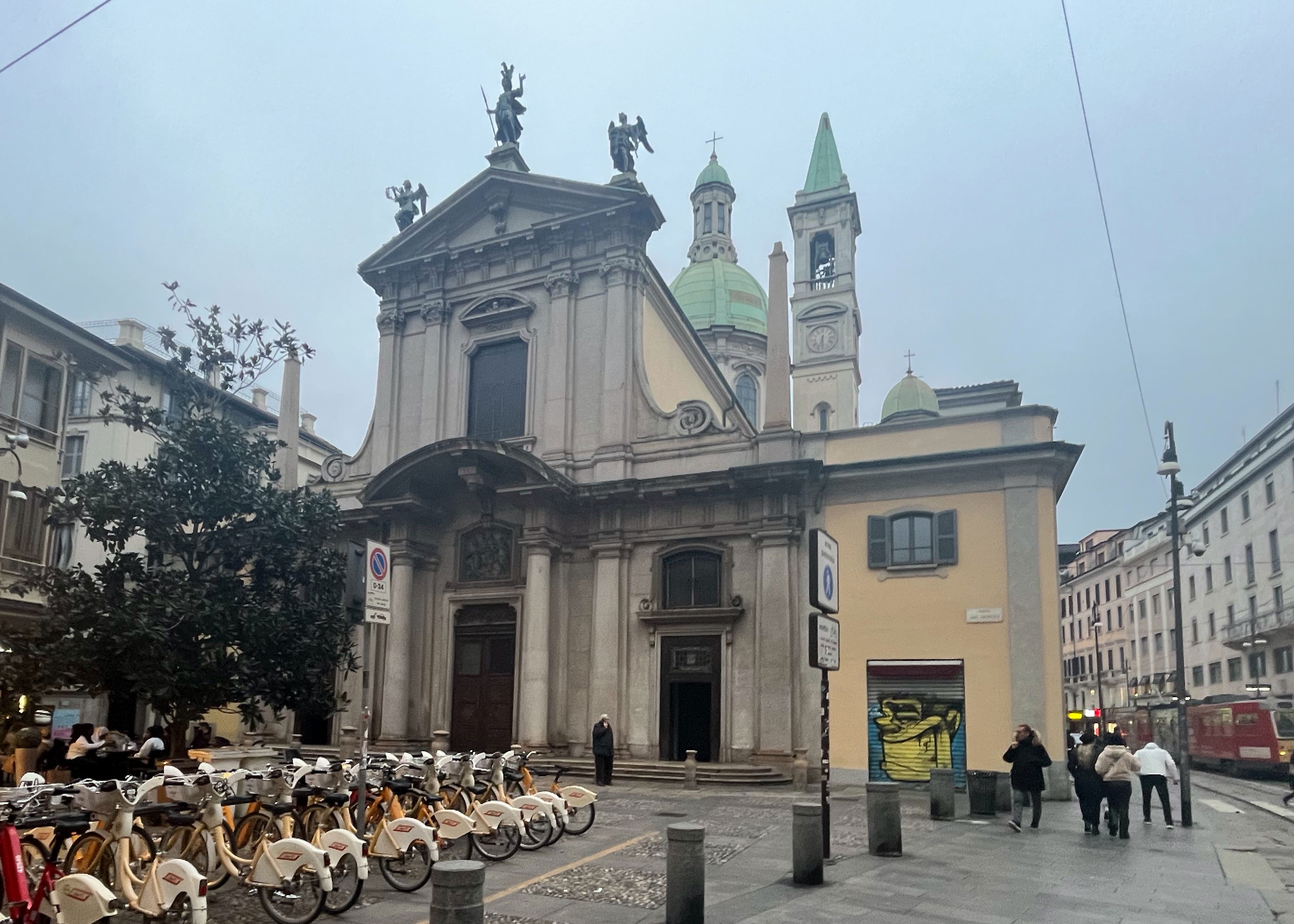
The first church on the site was built in 750 on the site by the bishop of Milan San Natale thanks to the funding of the Lombard Rachis, Duke of Friuli. It was built on the ancient remains of the imperial palace commissioned by Diocletian as the seat of the tetrarch that was supposed to govern one of the four parts into which the Roman Empire was divided with Milan as its capital.
San Giorgio is supposed also to be the burial place of San Natale. According to Milanese episcopal documents from the Middle Ages, Natale ruled the archdiocese of Milan, from 740 to 741, for fourteen months. He is supposed to have built the original church on the site on top of the ancient Roman palatium. Hence the name San Giorgio al Palazzo. The event of the foundation was commemorated with an epigraph on the bishop's tomb, which has now disappeared but was still reported by chroniclers of the sixteenth century; this inscription also stated that Natale had died at the age of 72 and extolled his excellent qualities in his office. Posthumous writers classified him as a man of great culture with a particular predilection or Latin, Greek and Hebrew. He proved to be a great opponent of the Arian heresy.
As mentioned, the church was apparently funded by Ratchis, Duke of Friuli and later King of Lombardy. Ratchis was the nephew of King Liutprand of the Lombards, who in 737 appointed him Duke of Friuli. This trust was repaid when Rachis prevented his brother Aistulf from killing Liutprand. Returning to Cividale ( in his Duchy of Friuli) , Ratchis earned some Kudos for leading an expedition to Carniola against the Slavs, who were a constant threat to the Lombard kingdom. Rachis was elevated to the throne of Pavia in 744, deposing Hildebrand, who seemed to have usurped the throne on Liutprand’s death. Despite his military prestige Ratchis was somewhat lacking in political skills, especially in dealing with the Franks. Without little from the Lombard warrior aristocracy, Rachis relied on support the small nobility of the "gasindi", a class of impoverished the freemen. He married a Roman woman, Tassia, and followed the Roman rite rather than the traditional Lombard rite. Starting from 746, instead of the traditional title of king of the Lombards, he was given the Romanizing title of princeps: a clear manifestation of his desire to place himself, in the wake of the Roman emperors, above the different ethnic groups that inhabited his kingdom. All this aroused the reaction of Lombard traditionalists and in 749 the assembly of the Lombards, meeting in Milan, deposed him and installed his brother Aistulf in his place. Rachis fled to Rome and retired to the abbey of Monte Cassino, which was possibly the only way to avoid being killed. When Aistulf died in 756, Ratchis attempted to regain the throne. He reached Pavia and took possession of the royal palace, however, the Duke of Tuscia, Desiderius, claimed the throne for himself, supported by Pope Stephen II and the Franks under Pepin the Short. After his brief return , in March 757 Rachis retired permanently to Monte Cassino.
Besides being the resting place of San Natale , the old church was also renowned as the home of the carroccio ( a large four-wheeled wagon around which the militia of Milan gathered and fought.) It was a sort of mobile armoured church, in which Priests celebrated Mass at the altar before the battle, a while trumpeters beside them encouraged the fighters to the fray. The wagon was generally pulled by oxen and carried an altar, a bell ("Martinella"), the heraldic signs of the city and a mast surmounted by a Christian cross, all being decorated with the flags and emblems of Milan . In battle the carroccio was surrounded by the bravest warriors in the army as the carroccio guard, and its capture by the enemy was regarded as an irretrievable defeat and humiliation, similar or worse to a British Infantry Regiment losing its colours. Documents of 1158 and 1201 confirm the presence of the Milanese carroccio at Giorgio ,where the archbishop of the church was responsible for lighting votive lamps around it. It was described in detail in 1288 by Bonvesin de la Riva in his book on the "Marvels of Milan", as being wrapped in scarlet cloth and drawn by three yoke of oxen, caparisoned in the white with the red crosses of Saint George,( the city's patron,) with a crucifix so massive it took four men to put it in place, like a ship's mast. As larger and more manoeuvrable armies began to appear, the municipal infantry was replaced by mercenaries, who being available to the highest bidder lacked emotional ties and belonging to the city. From a practical point of view the carroccio was not very mobile or agile, so modern warfare led to its obsolescence. With all that history it seems a shame that the old Medieval Church was replaced
In the twelfth century, the medieval church was replaced by a larger church. From the sixteenth century the building was affected by a series of interventions that modified its original appearance: in the sixteenth century some side chapels were built, including the chapel of the Passion, frescoed by Bernardino Luini. In 1623, it was renovated in Baroque style to a design by Francesco Maria Richini. In 1774, the new façade was built to a design by Francesco Croce: previously, it consisted of a simple brick wall with three Renaissance portals, the central one of which is surmounted by a decorated lunette. Between 1800 and 1821, Luigi Cagnola oversaw the radical restoration of the interior of the church and, in 1899, the neoclassical bell tower and dome were completed to a design by Alfonso Parrocchetti.
The interior of the church of San Giorgio al Palazzo is the result of alterations carried out by Luigi Cagnola. The plan is in the shape of a Latin cross with three naves, a slightly protruding transept and a deep apse. The hall is divided into three naves by two rows of round arches resting on Tuscan pillars. The central nave consists of two bays with ribbed vaults divided by a large arch resting on two Corinthian marble semi-columns; Each bay is lit by a rectangular window, one for each side wall. Each of the two side aisles, on the other hand, consists of four bays and is covered with a cross vault.
In the first chapel on the right there is Gaudenzio Ferrari's altarpiece St. Jerome, while on the fourth bay there is the Chapel of the Passion, little more than a niche, with a barrel vault and marble altar. The Chape l is also known as the capella del Corpus Domini.
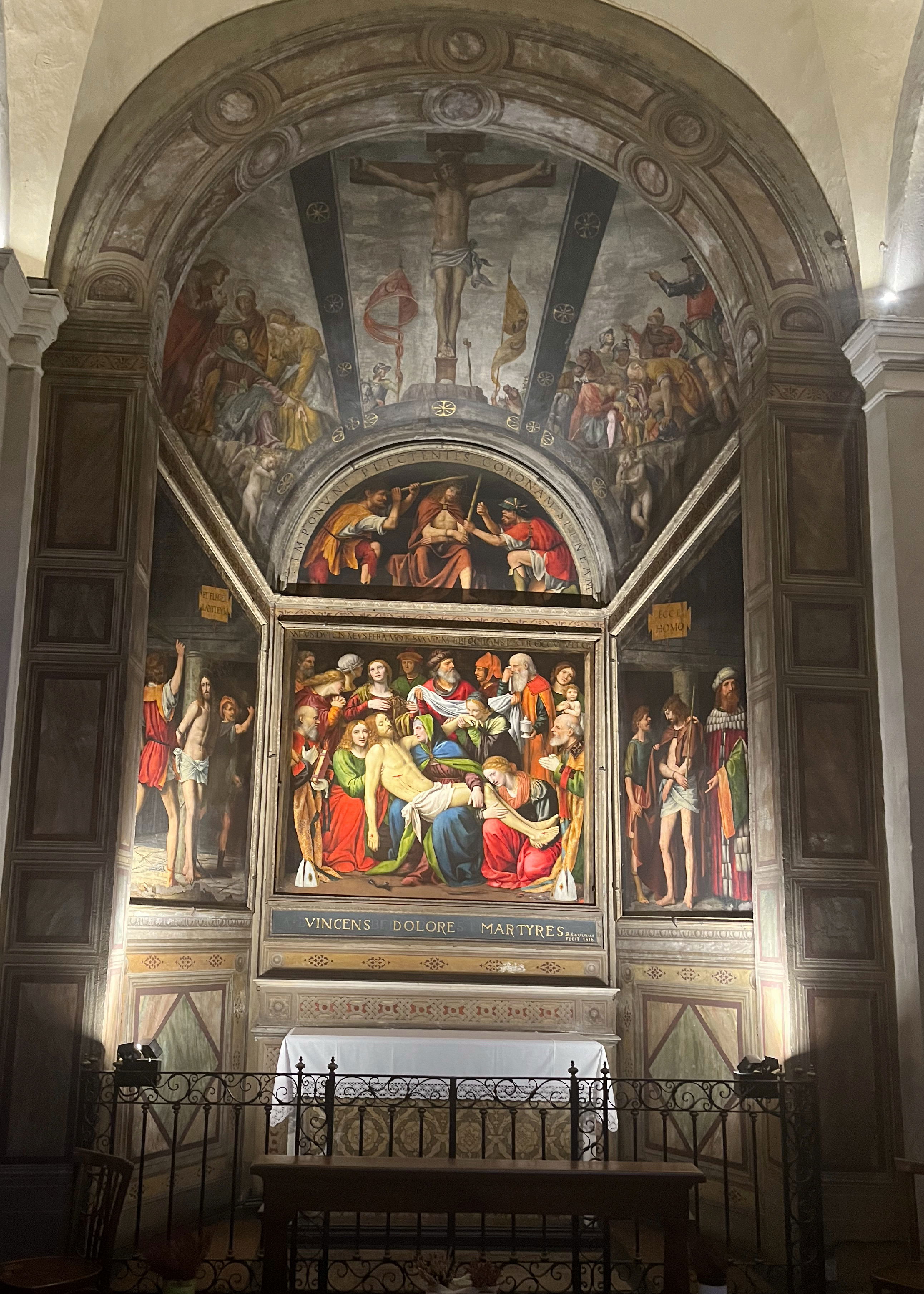
The walls are decorated with a cycle of panels by Bernardino Luini, dating back to 1516. On the central wall, above the altar, is the Lamentation over the Dead Christ, surmounted by the lunette of the Crowning of Thorns.
The Confraternity of Corpus Dominus , was a confraternity which was particularly concerned with the Corpus Christi Festival and the Eucharist. . In the Catholic Church the Eucharist is considered as a sacrament, according to the church the Eucharist is "the source and summit of the Christian life. The other sacraments, and indeed all ecclesiastical ministries and works of the apostolate, are bound up with the Eucharist and are oriented toward it. For in the blessed Eucharist is contained the whole spiritual good of the Church, namely Christ himself.” The confraternity’s activities included the maintenance of an altar in the church for keeping the Eucharistic Sacrament and taking the viaticum (the eucharist given to a person near death) out to the sick and dying . The brotherhood also observed daily mass, celebrated the octave ( eight days ) of Corpus Christi , gave bread and wine to the poor and did other charitable works. Unfortunately, most of the records of the Confraternity pf Corpus Dominus are no longer extant, so we are reliant on examples of what other confraternities did.
The chapel was designed for the display and veneration of the Eucharist, which had previously been displayed in less distinguished circumstances. In 1508, a certain Simone Barzo endowed the construction of a new chapel. It seems that the confraternity wanted to present a visual promotion of the Corpus Christi. Not just the bread and wine, but a representation of the real body and sacrifice of Jesus, The eucharist is represented as a reenactment of the passion and sacrifice of Jersus, rather than a commemorative meal. With at context in mind , the confraternity needed to hire a painter to provide the background for te veneration of the Eucharist. They commissioned Bernardino Luini for the work. Coincidentally the Consul of the confraternity was Andrea de Lovino, who from the name might suggest also like Bernardino , a native of Luino on Lake Maggiore. Whatever the connection, by 1516, Luini had already established a considerable reputation. In 1500 he had moved to Milan where he trained under Giovan Stefano Scotto and possibly Ambrogio Bergognone. In 1509 he had produced in Milan a polyptych, possibly for the Franciscans of which only St Anthony pf Padua remains and around 1512 the Madonna della Buonanotte at Cistercian monastic complex, the Abbey of Santa Maria di Rovegnano at Chiaravalle on the edge of Milan. He was presumably trusted with having a sufficient religious education to produce a passion cycle.
In keeping with Corpus Christi theme, the central panel, shows the deposition after the crucifixion. Jesus, with the gaping wound from the spear visible in his chest is supported by three women, probably the three Mary’s. The three Marys , mentioned as being present at the crucifixion in the gospel of St Johm are Mary ( the mother of Jesus) , Mary Magdalene and Mary of Clopas . Although there are some differences of opinion. Behind them the man holding the shroud is presumably Joseph of Arimathea and another possibly Nicodemus who attended the crucifixion, and who was traditionally depicted carrying a vessel containing the precious oil. We leave for another a time, a digression on whether Joseph ever made it to Glastonbury. Kneeling on either side of the scene, are two bishops who have left their mitres on the ground. The one holding the book, is possibly the learned founder of the church, San Natale. The other bishop is said to be the Pope, St Leo the Great , known for his spiritual leadership, aggressive opposition to heresy and for meeting with Attila the Hun. Legend has it that Leo met with Attila in Mantova after which Attila retreated back to Hungary. Since he had previously occupied and devastated Milan, the Milanese were undoubtedly very happy when he went home, so perhaps gratitude for Attila’s withdrawal explains St Leo’s presence . Of course, it might be somebody else. There a couple of other poignant details, on the floor is what sems to be one the nails of the cross, and the woman next St Joseph is holding the Crown of Thorns. These may also be a reminder that the painting was in Milan , where there were reputed to be one of the nails of the cross in the Cathedral and one of the ubiquitous bits of the Crown of Thorns at Santa Maria della Grazie.
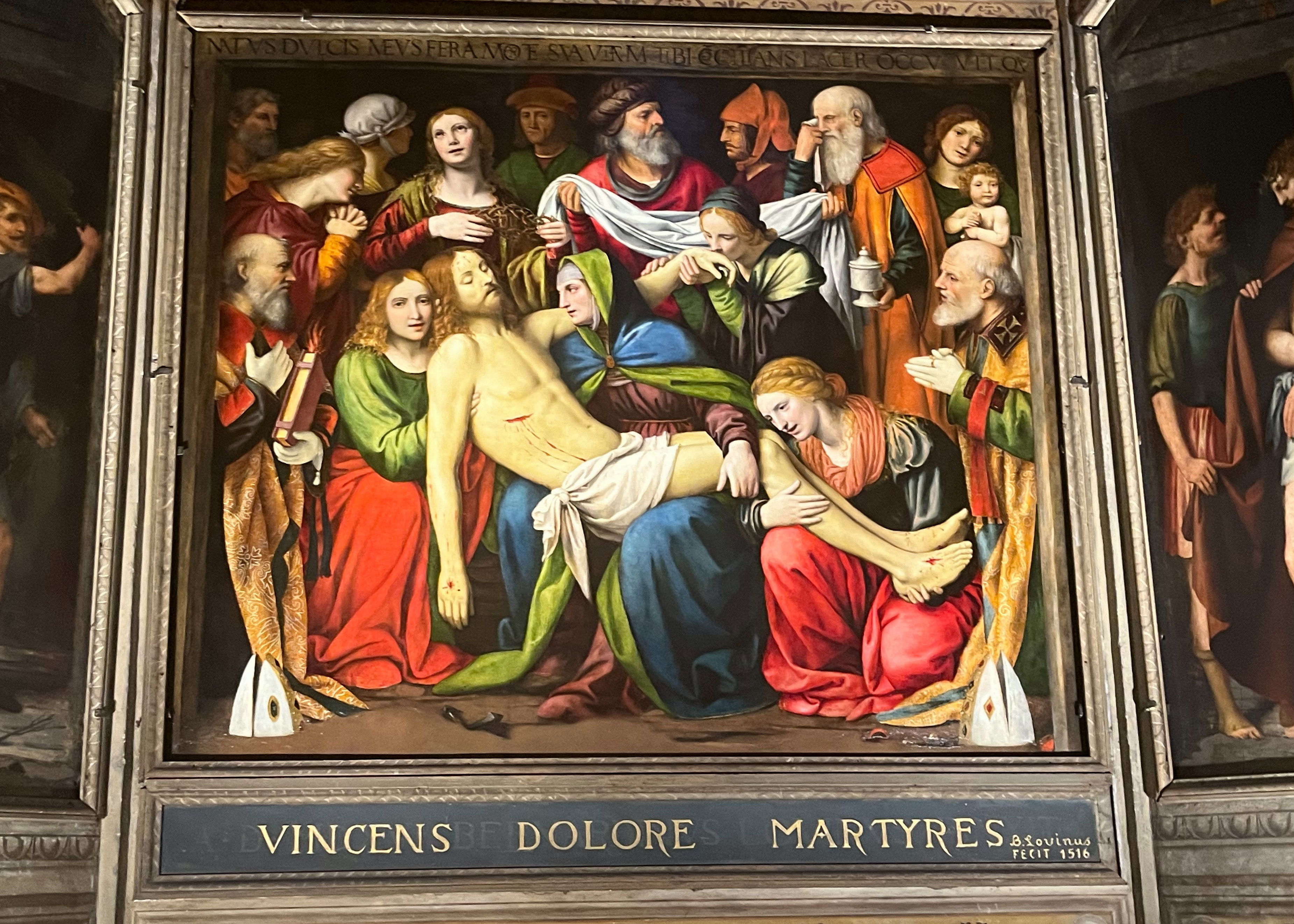
On the side of the chapel is Ecce Homo. The man in the ornamental robe is Pontius Pilate, although Luini does not portray him in Roman clothes, unlike the soldier on the right of Jesus, It has been suggested that the date is significant here. If the Painting is accurately dated to 1516, then there maty be some significance in the oriental attire. Although, the crusades were long finished in 1516 the Ottomans took Jerusalem and most of the Midde East from the Mamluks. So the biblical villain’s resemblance to a high Ottoman functionary might not be quite so coincidental. On the opposite side is a depiction of the scourging of Jesus. The lunette shows the placing of the Crown of Thorns, while roof itself shows the Crucifixion.
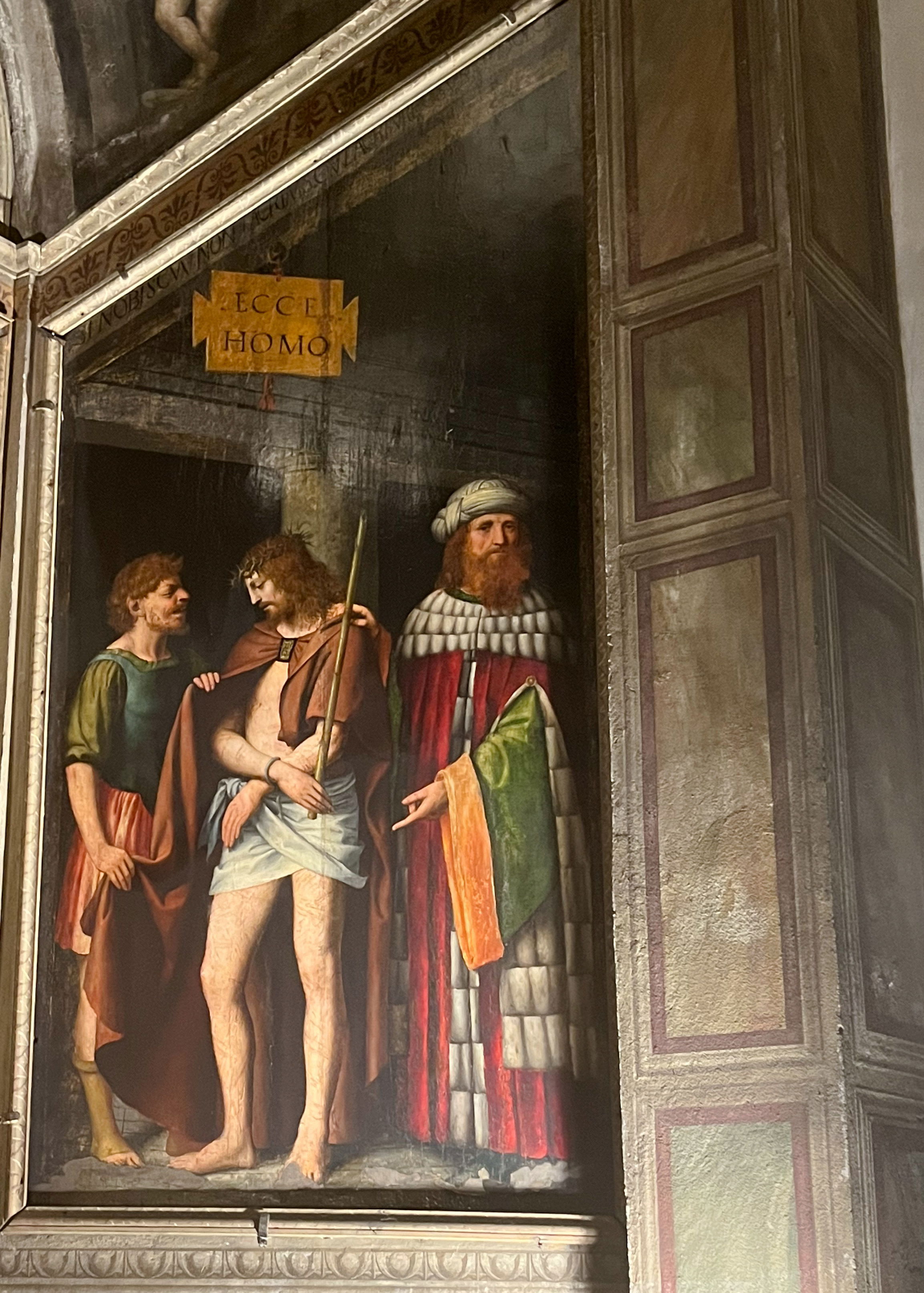
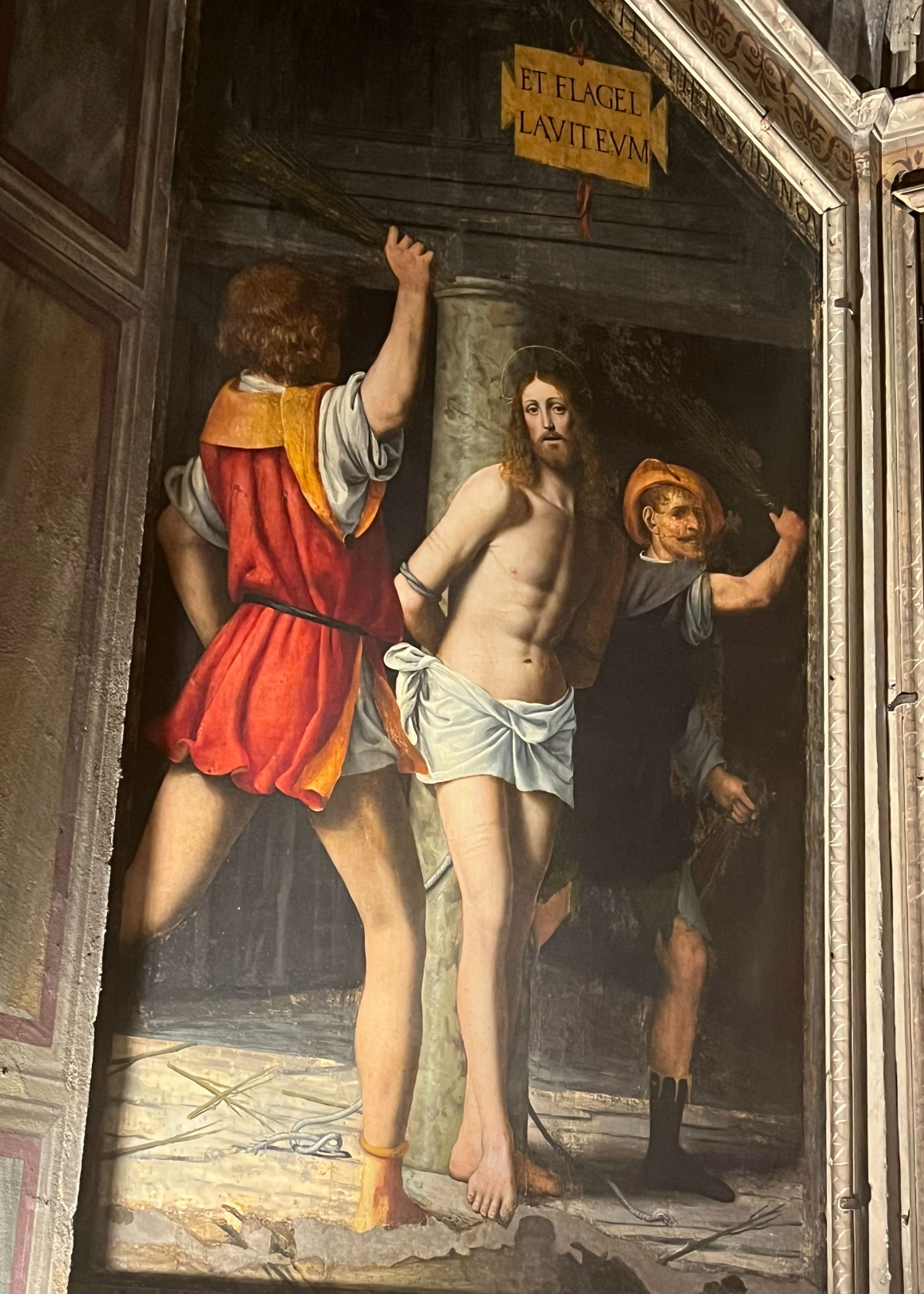
Legend has it that when Luini was working in the church of San Giorgio, the fresco work that he was executing greatly interested the parish priest of the church, who stepped upon the platform used by the artist and retreating to its extreme edge in order to judge of the work at a distance, missed his footing, fell over, and was killed on the spot There ensued a great storm of excitement and indignation, the church was polluted by reason of the death, and Luini was blamed for carelessness. The popular cry was for Luini's death in retribution, and the artist fled to Monza and took refuge in the family seat of the chief landowner of the district, the then head of the Pelucchi family.
At Pelucca Luini is said to have remained for two years and to have been employed in decorating the house with a wonderful series of frescoes ( now removed and what remains are in the Brera Gallery).Allegedly he fell in love with Laura the daughter of the owner, Guidotto Pelucchi, a girl of great beauty, who was much in demand by the eligible men of the district. There were two other suitors, men in her own circle of acquaintance, one of whom, Ferrigo Rabbia, was a great friend of Luini's and son of the Rabbia whose house he had decorated and whom Vasari mentions, and the other Amarotto de' Gavanti? These two men engaged in a tournament in order to decide who should have the fair Laura's affections, and the fortune of war was with Rabbia ; but before he could approach Laura, he and his friend Luini were set upon at night by Gavanti, and Rabbia was killed, while Luini escaped almost by a miracle. Laura would have nothing to do with Gavanti and apparently still favoured Luini; but her parents intervened, and she was shut up in a convent, and years afterwards it is said Luini discovered her at Lugano when he went there to execute his famous frescoes.
The people of Monza point to two places named Torneamento and Criminale, purportedly deriving their names from the Tournament and the Crime respectively. The former , was a place on the outskirts of Monza at San Fruttuoso, which was used for practising with weapons , not far away on what would have been the isolated and wooded outskirts of the city is a Cascina, known as Cascina Criminale , which is supposed to have been the scene of the crime. Luini was in Monza at some time , there is a fresco by him of San Gerardo in the Duomo (representing the patron sain of Monza) , and others in Monza may possibly have been his work. Whether the love story is true or not, Luini was certainly at San Giorgio, followed by La Pelucca and Monza
At San Giorgio, Luini created for the confraternity a theatrical scene around the Eucharist which allowed the devoted ( and the less devoted) to engage with Jesus’s sacramental body, while venerating the Eucharist. It was a means for the confraternity to direct devotion in the right direction in response to protested reforms in the north. The chapel’s role was relatively short lived, for in the 1550s Archbishop Carlo Borromeo decreed that the Eucharist should be placed on the main altar of the church instead. However , he did also insist that Luini’s work should not be removed from an Giorgio al Palazzo, where it fortunately survived Napoleonic occupation and British Aerial Bombardment to come down to the present day.